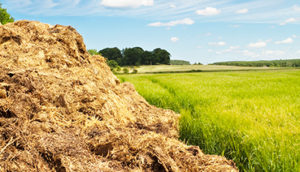Read the latest information on
Foot-and-mouth disease
 Many farmers use compost and manure for various soil structure and fertility benefits. But for both crop and livestock enterprises compost use is a potential pathway for the spread of diseases, pests and weeds.
Many farmers use compost and manure for various soil structure and fertility benefits. But for both crop and livestock enterprises compost use is a potential pathway for the spread of diseases, pests and weeds.
Farmers graze animals and grow crops after spreading compost and/or manure from other farms and various other sources (for example plant, feedlot, dairy, pig or chicken waste).
Stuart Kearns, Manager for Farm Biosecurity Programs at Plant Health Australia, advised that compost, if not handled appropriately, can also bring biosecurity risks on farm.
Some Australian state and territory governments do have guidelines for the production of compost, for example Victorian and NSW Environment Protection Agencies), but there are no compliance measures to enforce (unless serious complaints are made for smell).
Although there are rules for compost, soil conditioners and mulches (Australian Standard AS4454 2012), the products are largely unregulated and it can often be difficult to differentiate and identify source material.
Mr Kearns said that if the compost is thoroughly mixed, turned and aerated, the temperatures reached in the material, along with microbial attack and chemical degradation should be sufficient to destroy pests, diseases and weed seeds, producing a valuable resource.
“There is scientific knowledge regarding the survival of diseases, pests and weed seeds during the process of composting including what practices will reduce the risk,” added Mr Kearns.
Producers of quality compost manage these key steps in the process to ensure the product conforms to requirements and is fit for purpose, meeting a set of specifications.
“Some composting businesses keep records of the source materials used and measure the temperature, pH and oxygen levels to ensure that this occurs. They use the records of the testing history to assure buyers of the quality of the product,” he said.
Additional testing of nutritional performance and indicator pathogens such as faecal coliforms and Salmonella species may also be available with some contractors.
Even so, there are so many disease causing organisms, such as fungal spores, that can survive the composting process.
“With so many variables at play, it is particularly important that producers try to ensure the quality of the compost they use on their farms and to make sure they follow sound biosecurity practices to ensure that it is not a source of diseases, pests and weeds,” said Mr Kearns.
Here are a few things you can do to secure your farm against the biosecurity risks associated with the use of compost:
Applying compost and biosolids to land (NSW Environment Protection Authority)
Agricultural guidance (Victorian Environment Protection Authority)
Certification information: Composting guidelines (National Association for Sustainable Agriculture Australia)
* This is the same withholding period as for poultry litter or manure that is spread on pasture paddocks. If there is still compost visible on the pasture, the withholding period will need to be longer.